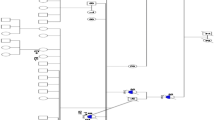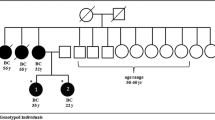Abstract
Introduction: Germline mutations of BRCA1 and BRCA2 account for the majority of hereditary breast cancers, many of which are classified as variants of unknown significance (VUS). We report the identification of a novel BRCA2 variant (c.7806-9T > G) in a Chinese family with multiple breast cancers and document it as a pathogenic mutation. Methods: The proband in this family was diagnosed with breast cancer at age 50 with a strong family history of breast cancer. DNA and RNA were extracted from the blood of the proband and her family, and was used for BRCA gene mutation/deletion screening and RNA splicing analysis. Results: BRCA2 c.7806-9T > G was identified in the proband, which was suggestive of a variant. This change was also found in two sisters of the proband with a history of breast cancer, as well as from the proband’s maternal gastric cancer. The only sibling free of breast cancer did not carry the BRCA2 variant, thus demonstrating that the mutation segregates with the clinical phenotype in this family. RNA analysis on the proband blood sample revealed three aberrant splicing variants: c.7806_7874del, c.7806_7976del, and c.7806-8_7806-1ins. The latter causes a frameshift and creates a truncated protein, whilst the other two splicing variants resulted in shorter forms of the protein. Conclusions: The identified BRCA2 c.7806-9T > G [Genbank: DQ889340] was found to be pathogenic, based on aberrant splicing events resulting in the formation of truncated protein products. Thus, better understanding and classification of BRCA variants as neutral or disease causing has important implications for genetic counseling so that appropriate management can be given.






Similar content being viewed by others
Abbreviations
- DCIS:
-
Ductal carcinoma in situ
- MLPA:
-
Multiplex ligation-dependent probe amplification
- PAGE:
-
Polacrylamide gel
- RT-PCR:
-
Reverse-transcription polymerase chain reaction
- VUS:
-
Variant of unknown significance
References
Miki Y et al (1994) A strong candidate for the breast and ovarian cancer susceptibility gene BRCA1. Science 266(5182):66–71
Wooster R et al (1994) Localization of a breast cancer susceptibility gene, BRCA2, to chromosome 13q12–13. Science 265(5181):2088–2090
Ford D, Easton DF, Peto J (1995) Estimates of the gene frequency of BRCA1 and its contribution to breast and ovarian cancer incidence. Am J Hum Genet 57(6):1457–1462
Claus EB et al (1996) The genetic attributable risk of breast and ovarian cancer. Cancer 77(11):2318–2324
Ford D et al (1998) Genetic heterogeneity and penetrance analysis of the BRCA1 and BRCA2 genes in breast cancer families. The Breast Cancer Linkage Consortium. Am J Hum Genet 62(3):676–689
Struewing JP et al (1997) The risk of cancer associated with specific mutations of BRCA1 and BRCA2 among Ashkenazi Jews. N Engl J Med 336(20):1401–1408
Claes K et al (2004) BRCA1 and BRCA2 germline mutation spectrum and frequencies in Belgian breast/ovarian cancer families. Br J Cancer 90(6):1244–1251
Frank TS et al (2002) Clinical characteristics of individuals with germline mutations in BRCA1 and BRCA2: analysis of 10,000 individuals. J Clin Oncol 20(6):1480–1490
Hamann U et al (2003) Similar contributions of BRCA1 and BRCA2 germline mutations to early-onset breast cancer in Germany. Eur J Hum Genet 11(6):464–467
Ikeda DM et al (2001) Development, standardization, and testing of a lexicon for reporting contrast-enhanced breast magnetic resonance imaging studies. J Magn Reson Imaging 13(6):889–895
Nanda R et al (2005) Genetic testing in an ethnically diverse cohort of high-risk women: a comparative analysis of BRCA1 and BRCA2 mutations in American families of European and African ancestry. JAMA 294(15):1925–1933
Panguluri RC et al (1999) BRCA1 mutations in African Americans. Hum Genet 105(1–2):28–31
Tiling R et al (2001) 18F-FDG PET and 99mTc-sestamibi scintimammography for monitoring breast cancer response to neoadjuvant chemotherapy: a comparative study. Eur J Nucl Med 28(6):711–720
Sng KW et al (2000) Spectrum of abnormal mammographic findings and their predictive value for malignancy in Singaporean women from a population screening trial. Ann Acad Med Singapore 29(4):457–462
Suter NM et al (2004) BRCA1 and BRCA2 mutations in women from Shanghai China. Cancer Epidemiol Biomarkers Prev 13(2):181–189
Zhi X et al (2002) BRCA1 and BRCA2 sequence variants in Chinese breast cancer families. Hum Mutat 20(6):474
Zhou P, Gautam S, Recht A (2007) Factors affecting outcome for young women with early stage invasive breast cancer treated with breast-conserving therapy. Breast Cancer Res Treat 101(1):51–57
de Barros N et al (2001) Cutaneous myiasis of the breast: mammographic and us features-report of five cases. Radiology 218(2):517–520
Goldgar DE et al (2004) Integrated evaluation of DNA sequence variants of unknown clinical significance: application to BRCA1 and BRCA2. Am J Hum Genet 75(4):535–544
Ng K, Yip K, Choi C (2003) A case of oral myiasis due to Chyrsomya bezziana. Hong Kong Med J 9:454–456
Hu Z et al (2003) The analysis of BRCA1 mutations in eastern Chinese patients with early onset breast cancer and affected relatives. Hum Mutat 22(1):104
Wappenschmidt B et al (2005) Strong evidence that the common variant S384F in BRCA2 has no pathogenic relevance in hereditary breast cancer. Breast Cancer Res 7(5):R775–R779
Bunyan DJ et al (2004) Dosage analysis of cancer predisposition genes by multiplex ligation-dependent probe amplification. Br J Cancer 91(6):1155–1159
Hogervorst FB et al (2003) Large genomic deletions and duplications in the BRCA1 gene identified by a novel quantitative method. Cancer Res 63(7):1449–1453
Sellner LN, Taylor GR (2004) MLPA and MAPH: new techniques for detection of gene deletions. Hum Mutat 23(5):413–419
Lazovich D et al (1999) Breast conservation therapy in the United States following the 1990 National Institutes of Health Consensus Development Conference on the treatment of patients with early stage invasive breast carcinoma. Cancer 86(4):628–637
Schuelke M (2000) An economic method for the fluorescent labeling of PCR fragments. Nat Biotechnol 18(2):233–234
Yau TK et al (2002) Breast conservation treatment in Hong Kong-early results of 203 patients: retrospective study. Hong Kong Med J 8(5):322–328
Reese MG et al (1997) Improved splice site detection in Genie. J Comput Biol 4(3):311–323
Drew PJ et al (2001) Evaluation of response to neoadjuvant chemoradiotherapy for locally advanced breast cancer with dynamic contrast-enhanced MRI of the breast. Eur J Surg Oncol 27(7):617–620
Campos B et al (2003) RNA analysis of eight BRCA1 and BRCA2 unclassified variants identified in breast/ovarian cancer families from Spain. Hum Mutat 22(4):337
Durocher F et al (1996) Comparison of BRCA1 polymorphisms, rare sequence variants and/or missense mutations in unaffected and breast/ovarian cancer populations. Hum Mol Genet 5(6):835–842
Hartmann LC et al (1999) Clinical options for women at high risk for breast cancer. Surg Clin North Am 79(5):1189–1206
Phelan CM et al (2005) Classification of BRCA1 missense variants of unknown clinical significance. J Med Genet 42(2):138–146
Krawczak M, Reiss J, Cooper DN (1992) The mutational spectrum of single base-pair substitutions in mRNA splice junctions of human genes: causes and consequences. Hum Genet 90(1–2):41–54
Chen X et al (2006) Intronic alterations in BRCA1 and BRCA2: effect on mRNA splicing fidelity and expression. Hum Mutat 27(5):427–435
Bieche I, Lidereau R (1999) Increased level of exon 12 alternatively spliced BRCA2 transcripts in tumor breast tissue compared with normal tissue. Cancer Res 59(11):2546–2550
Brinkman BM (2004) Splice variants as cancer biomarkers. Clin Biochem 37(7):584–594
Lu M et al (1996) Characterization of functional messenger RNA splice variants of BRCA1 expressed in nonmalignant and tumor-derived breast cells. Cancer Res 56(20):4578–4581
The Breast Cancer Linkage Consortium (1999) Cancer risks in BRCA2 mutation carriers. J Natl Cancer Inst 91(15):1310–1316
Jakubowska A et al (2002) BRCA2 gene mutations in families with aggregations of breast and stomach cancers. Br J Cancer 87(8):888–891
Li N et al (2006) BRCA1 germline mutations in Chinese patients with hereditary breast and ovarian cancer. Int J Gynecol Cancer 16(Suppl 1):172–178
Hong CC et al (2004) Cytochrome P450 1A2 (CYP1A2) activity, mammographic density, and oxidative stress: a cross-sectional study. Breast Cancer Res 6(4):R338–R351
Cheung KL et al (2001) Palpable asymmetrical thickening of the breast: a clinical, radiological and pathological study. Br J Radiol 74(881):402–406
Acknowledgements
We would like to thank Dr Walton WT Li, superintendent of the Hong Kong Sanatorium and Hospital and the Dr Ellen Li Charitable Foundation for their support of the Hong Kong hereditary and high-risk breast cancer programme.
Author information
Authors and Affiliations
Corresponding author
Rights and permissions
About this article
Cite this article
Kwong, A., Wong, L.P., Chan, K.Y.K. et al. Characterization of the pathogenic mechanism of a novel BRCA2 variant in a Chinese family. Familial Cancer 7, 125–133 (2008). https://doi.org/10.1007/s10689-007-9155-7
Received:
Accepted:
Published:
Issue Date:
DOI: https://doi.org/10.1007/s10689-007-9155-7




